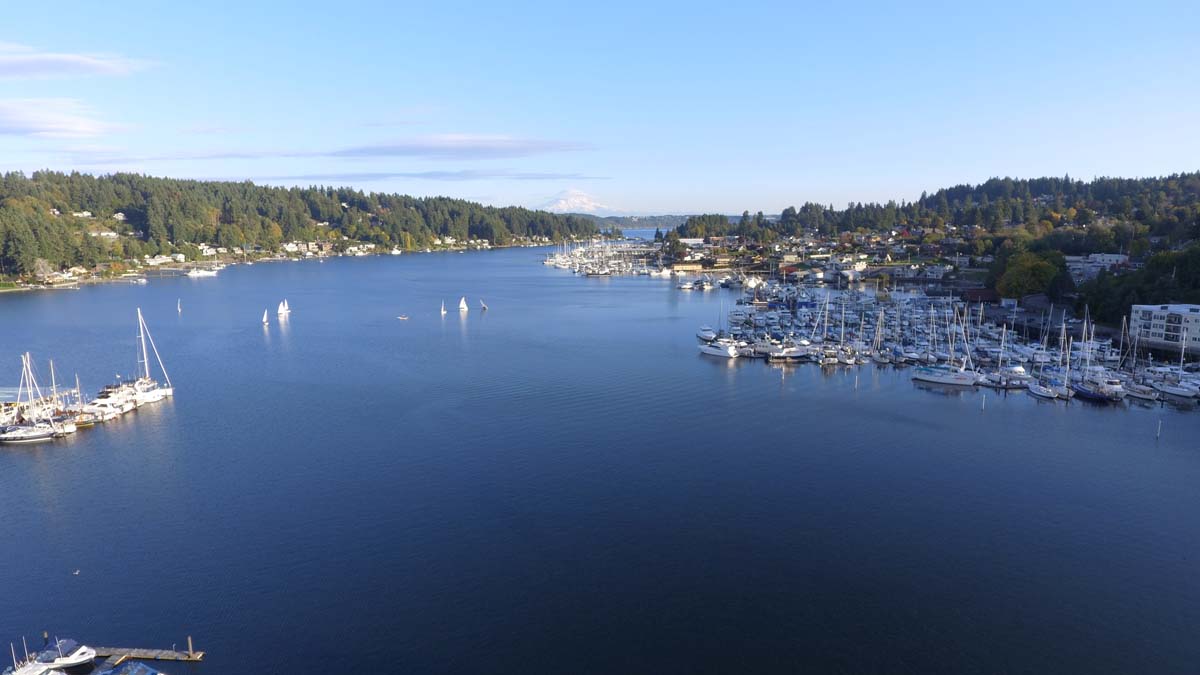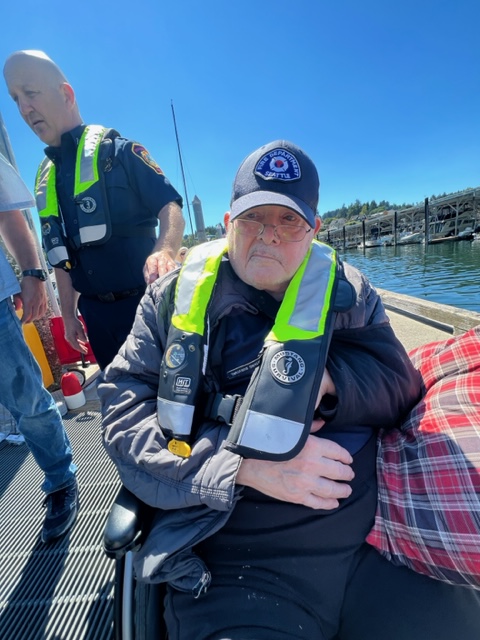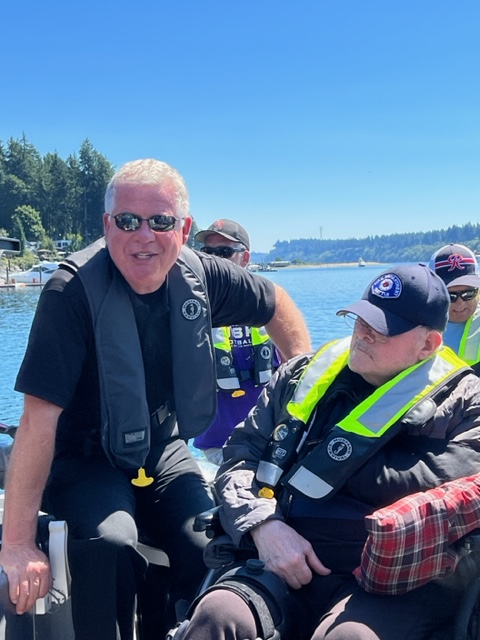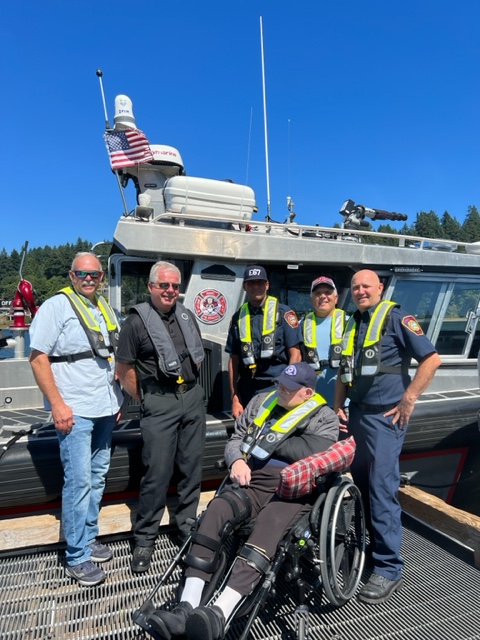Dr. Michael Copass, who’s lived at Penrose Harbor for three years, recently reunited with a friend he’s known for decades through Medic One, the Seattle-based paramedic training program that has garnered worldwide attention since the early 1970s.
Dave Mataftin retired this month as fire chief at South King Fire and Rescue (SKFR), after nearly 50 years of service with the fire department. As a special surprise, Sandi Semler, the social services coordinator at Penrose Harbor, and Jerry Clos, the captain at SKFR, planned a celebration in mid-August for Dave at Gig Harbor, and Sandi arranged for Dr. C. to be there.
According to Dr. C., “Mataftin was a loyal, hard-working, intelligent member of the fire service. He was a real asset [who made it possible for the fire service to] do more with what they had, and better serve the community with the same amount of money. He was that kind of far-sighted fire official.”
It was more than a reunion of two long-time friends. Dr. C. is at least partly responsible for extending Dave’s career by about a decade, which helps explain why the chief felt honored to see Dr. C. at the celebration.
To thank Dave for helping SKFR secure the Zenith, a new maritime emergency response vessel SKFR put in service a year ago, Jerry wanted to take him on one more ride on the fireboat. To everyone’s delight, Dr. C. joined them for a spin around the harbor.
The Extra Decade
Around 10 years ago, Dave experienced an intracranial hemorrhage after being bumped in the head with a piece of machinery. Although his regular physician initially didn’t find any significant injury, Dave knew something wasn’t right.
He persisted, and when he found out about the head bleed, Dave called two people: his wife and Tom Gudmestad, one of King County’s earliest Medic One paramedics, who worked closely with Dr. C. Tom then contacted Dr. C.
At the time, Dr. C. was a practicing neurologist and director of emergency services at Harborview Medical Center in Seattle, in addition to being responsible for the Medic One training program.
He says, “We got [Dave] from his home to the medic unit to the emergency room to the operating room in one smooth transition.” In the OR, neurosurgeons removed a clot that had been detected during a CT scan, and Dave “woke up completely normal,” according to Dr. C.
Although Dr. C. doesn’t take credit for saving Dave’s life, he says his friend “would not have been in any shape to continue his service to the fire department” if the Medic One team and the hospital hadn’t acted so swiftly.
How a Neurologist Helped Make Seattle the Best Place to Have a Heart Attack
Dr. C. served as a general medical officer in the U.S. Army during the Vietnam War. He received his medical education before enlisting as a captain, but had not yet completed a residency.
After being discharged in the late 1960s, Dr. C. headed for Chicago, hoping to restart a residency in general medicine at Northwestern University. That didn’t work out quite as he’d planned.
“Best thing that ever happened was to be denied access to that residency, so I had to make do,” he says. “I made do by getting on a red-eye to Seattle,” which is where he’d grown up.
He earned a residency in neurology at Harborview Medical Center, where he “fell into cahoots with” Dr. Leonard Cobb, the chief of cardiology at University of Washington School of Medicine.
Dr. Cobb’s Collaboration With the Fire Chief
After reading about first responders in Belfast, Ireland, who were saving lives by bringing emergency medical care to people who’d experienced cardiac arrest, Dr. Cobb (who passed away last February) came up with the idea of training local firefighters in pre-hospital emergency medical care. Firefighters were always on duty and could respond quickly if someone in their service area was having a heart attack. With the right training, the firefighters could keep patients alive until they reached the hospital, where physicians and other medical staff could take over.
Dr. Cobb shared his ideas with Gordon Vickery, Seattle’s fire chief, in 1968, and the two developed a paramedic training course for firefighters that would become known as Medic One.
Moby Pig
During his residency, Dr. C. spent a substantial amount of time in Harborview’s emergency department (and became its medical director at 34). Every day, he says, he would see these “big, burly firemen” driving a red and white mobile unit they called Moby Pig because it was so large and hard to steer. The firemen were “bringing in patients who supposedly had been dead, but now they were alive again, moving and talking.”
Dr. C. took a keen interest in what they were doing, and Dr. Cobb asked if he would draw upon his knowledge as a neurologist to teach the firefighters about the human nervous system.
Meanwhile, in 1972, in tandem with Medic One, other members of the community began receiving “citizen CPR” training through a program called Medic Two. The goal, Dr. C. says, was to teach one-fifth of Seattle’s population how to do CPR.
In 1974, the TV program “60 Minutes” did a segment on Medic One, during which Morley Safer referred to Seattle as “the best place in the world to have a heart attack.”
Eventually, Dr. C. took over responsibility for developing the entire Medic One training program and “making sure the entire system worked together.”
Medic One Takes Wings
A house fire in 1982 in Sitka, Alaska, claimed the lives of three children. Dr. C. was in Sitka, giving a lecture, when it happened.
After receiving a call for help, Dr. C. tried to get one of the children, a 12-year-old girl, to Harborview’s burn center, which was 850 miles away. Unfortunately, by the time he could arrange her flight to Seattle, too much time had passed, and she died during the flight.
The experience led Dr. C. to apply Medic One’s underpinnings to a new collaboration between the UW School of Medicine and Harborview Medical Center called Airlift Northwest.
Initially, the air ambulance service used one small plane based in Seattle to fly trained staff to people who needed trauma care but were too far away from the hospital to receive it in time. Airlift Northwest flew patients to Harborview Medical Center, or a closer hospital if it could provide the necessary care.
Today, Airlift Northwest has a fleet of small planes and helicopters outfitted as “ICUs in an aircraft.” The program has partnerships with hospitals throughout Washington as well as Alaska, Idaho, Montana and Wyoming.
Dr. C.’s Retirement
After 35 years as the director of emergency services at Harborview, Dr. C. stepped down from that role in 2008 to spend more time with his family. He also retired as the medical director of Airlift Northwest, but stayed on at Harborview as medical director of Seattle Medic One. He also continued to see patients in Harborview’s neurology clinic.
Dr. C. fully retired five years later after having a stroke, leaving an extraordinary legacy.
Even with all of his work making Medic One an exemplary service that would be replicated all over the world, and his considerable contributions in making Harborview Medical Center the only facility across Washington, Alaska, Idaho and Montana that provides Level I trauma care (as well as one of the country’s highest-volume trauma centers), Dr. C. may be best known at Harborview for his sense of social justice and excellence in care.
In particular, he was known for emphasizing that all patients were to be treated with equal respect and attention to care, advising the staff to approach their work as if “every patient who walks in the door at Harborview is the president of Seafirst Bank.”
Dr. C.’s wife, Lucy, still lives in their home in Port Angeles, which they were building for their retirement when Dr. C. fell ill. Although Port Angeles is about a two-hour drive from Penrose Harbor, Lucy says when it was time to find a more advanced level of care than Dr. C. could receive at home, they “sacrificed proximity to get better care and nicer surroundings” at Penrose Harbor.
One of their daughters lives near Port Angeles and their other daughter lives not too far from Penrose Harbor. Their son lives in California. Lucy and Dr. C. also have four grandchildren.
More Fascinating Stories
Dr. C. isn’t the only resident in our community who’s led a remarkable life. You’d be amazed by how many have a captivating story (or several) to share.
What’s also impressive is how many residents at Heron’s Key and Penrose Harbor continue to inspire others, give of themselves and make the world a better place in ways large and small.
If these sound like the kind of people you’d like to have as neighbors, and you’d like to know more about Heron’s Key, contact us and we’ll arrange a time for you to visit!




